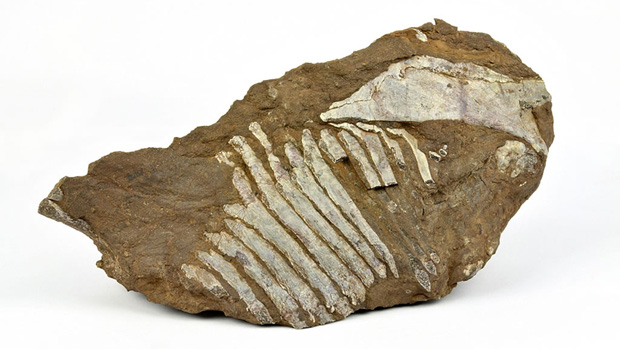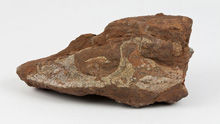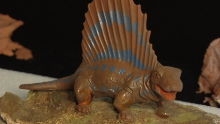
A family and their dog named Kitty have stumbled upon one of the most significant fossil finds ever in Nova Scotia.
The reptile fossil, affectionately nicknamed "Superstar," is the first of its kind to be found in the province.
While out walking along Nova Scotia's fossil-rich Northumberland shore, Patrick Keating, his family, and their dog, Kitty, found a fossilized rib cage, backbone and partial sail.
When they went back to the same area a week later, they found the creature's fossilized skull.

"We really had no idea how significant this was," said Keating. "My brother Peter and his kids took the pieces to the Nova Scotia Museum and when we learned what they were, we were truly amazed and so glad we brought them in."
Researchers estimate the reptile lived between 290 and 305 million years ago, during the Carboniferous Period or early Permian Period.
Based on fossil evidence, researchers believe Superstar was a juvenile, measuring about one metre long, weighing in at about 15 kilograms.
Paleontologists and other staff from the Museum of Natural History, the Fundy Geological Museum and the Joggins Fossil Institute are working together to unravel the mystery.
"A new window into our ancient world has just opened," said Deborah Skilliter, curator of geology for the Nova Scotia Museum. "This is just the beginning of the story as we undertake the task of determining exactly what type of sail-back reptile Superstar is, where, and how, it lived and died."
Previously, scientists had discovered fossilized footprints in Colchester County and a few scattered bones on P.E.I., but Superstar is the most complete specimen to date.
Skilliter and other researchers are very excited.
"This is one of the most significant fossils that's come out of the province in recent history," she said.
"This was a land creature. Land creatures don't get preserved as easily as water creatures, aquatic things - so it's rare that we get a land animal ...150 years of paleontological research in the province and not a single bone, and here we get almost the whole darn thing."
The fossil comes from a branch of reptiles described as mammal-like as they are thought to be the ancient ancestors of modern mammal species.
The original find has led to the discovery of a dragonfly wing fossil at the same site, one of five discovered in Nova Scotia.
"This is a great day for Nova Scotians and the world," said Leonard Preyra, Minister of Communities, Culture and Heritage in a statement.

"These fossils of extinct animals connect us to our past by helping to tell the story of Nova Scotia's and the earth's history. This enriches our lives today and gives us insight for the future."
Preyra commended the family for doing the right thing by bringing the fossils to the attention of the museum.
"This is the perfect example of why the Special Places Protection Act is in place," he said. "The act allows fossils to be properly researched, displayed and enjoyed by thousands of people for years to come."
The Special Places Protection Act protects important archaeological, historical and paleontological sites and remains, including those underwater.
The fossil will be on display at the Museum of Natural History in Halifax from Aug. 18 to Sept. 3.




I wonder what the dog thought. Bunch of bones.